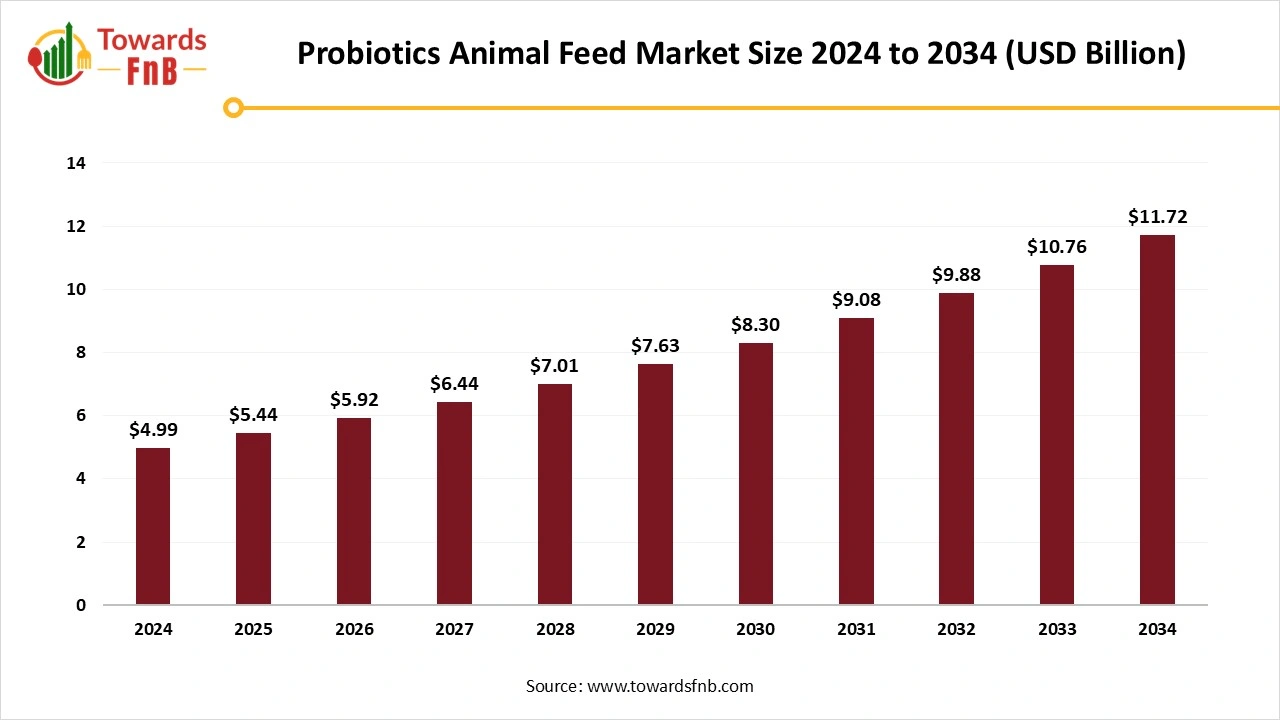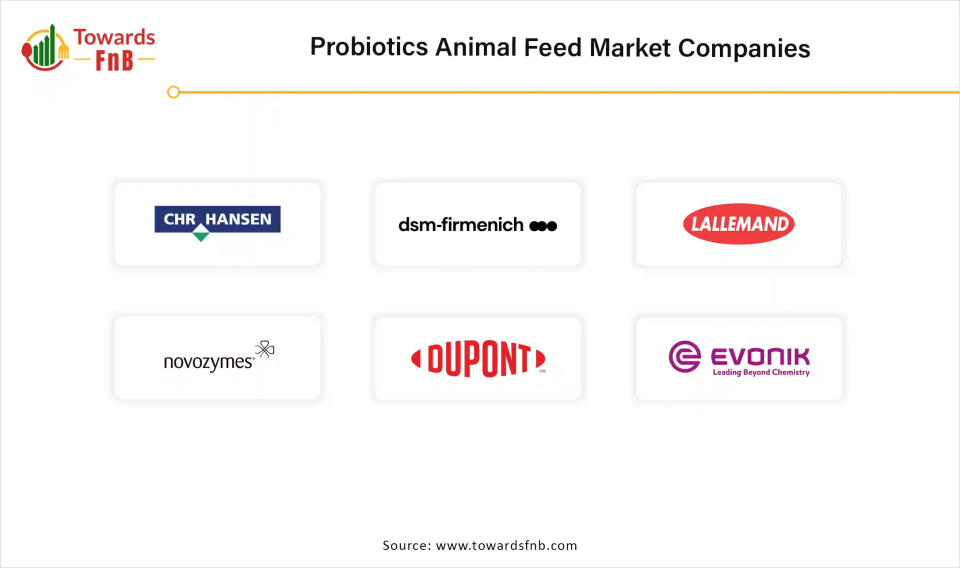September 2025
The global probiotics animal feed market size was estimated at USD 4.99 billion in 2024 and is expected to rise from USD 5.44 billion in 2025 to nearly reaching USD 11.72 billion by 2034, growing at a CAGR of 8.86% during the forecast period from 2025 to 2034. The market is growing due to rising demand for the antibiotic-free and sustainable livestock production.

| Study Coverage | Details |
| Growth Rate from 2025 to 2034 | CAGR of 8.86% |
| Market Size in 2025 | USD 5.44 Billion |
| Market Size in 2026 | USD 5.92 Billion |
| Market Size by 2034 | USD 11.72 Billion |
| Largest Market | Asia Pacific |
| Base Year | 2024 |
| Forecast Period | 2025 to 2034 |
| Regions Covered | North America, Europe, Asia-Pacific, Latin America, and Middle East & Africa |
Antibiotic resistance is an escalating issue for livestock farmers. A 2019 WHO report estimated that infections resistant to antibiotics result in more than 700,000 human fatalities each year, with projections indicating that this figure could surpass 10 million by 2050. Consequently, there is a growing need for non-antibiotic alternatives to enhance feed efficiency and the survival of livestock.
The increase in antibiotic-free livestock farming has boosted the need for natural feed supplements that enhance immune health. The creation of premium probiotics requires sophisticated technologies and rigorous quality control procedures, which can raise expenses. This results in probiotics being pricier than conventional feed additives, which may hinder their adoption, particularly in price-sensitive markets.
Current developments in animal feed probiotics reveal trends that are influencing their future. Precision microbiome management tailors’ probiotics to the gut ecosystems of animals for enhanced interventions. Synbiotics, formed by merging probiotics with prebiotics, are also attracting interest for their synergistic effects.
The potential of probiotics in the future is vast, enhanced by state-of-the-art progress in microbiome management, formulation methods, and creative applications. Interdisciplinary collaboration and a constant dedication to research will keep propelling probiotic development, creating a sustainable and prosperous future for agriculture and animal nutrition.
One major barrier is the elevated expense linked to creating premium probiotic formulations, which can be a deterrent for smaller participants in the industry. Creating high-quality probiotics requires sophisticated technologies and stringent quality control procedures, which can drive up expenses. This causes probiotics to be pricier than conventional feed additives, which may restrict their use, particularly in budget-conscious markets.
Asia Pacific Dominated the Probiotics Animal Feed Market in 2024.
The increasing population and elevating disposable incomes in the Asia-Pacific region have led to greater meat consumption, driving the demand for feed probiotics to enhance animal health and productivity. This considerable increase in meat consumption requires improved animal nutrition strategies, like feed probiotics, which can enhance feed conversion rates and support healthier livestock growth. Key markets such as China and India have implemented fresh regulations for the registration and use of feed additives, highlighting the significance of product safety and effectiveness. These regulatory changes have resulted in heightened investment in quality assurance practices and testing infrastructures. The demand for probiotics in animal feed is growing considerably in the Asia Pacific region, driven by increasing awareness of probiotics and the need for superior animal nutrition.
Improving cattle health and productivity is crucial because of the growing middle class and increasing population. The sector is undergoing a major change fueled by heightened consciousness of animal nutrition and well-being, along with the rising embrace of sustainable agricultural methods. The movement towards natural feed additives has been especially notable in commercial farming, as farmers are increasingly acknowledging the advantages of probiotics for enhancing animal health and productivity. This shift is additionally reinforced by the government's focus on minimizing antibiotic use in animal feed, resulting in greater adoption of probiotic substitutes.
Latin America Expects the Notable Growth in the Market During the Forecast Period.
Fueled by a rising need for quality animal protein and heightened consciousness of animal health among livestock producers. The growth of livestock and poultry production in the region fuels market expansion, with Brazil and Argentina being key players in global meat exports. The increase in regional meat consumption has prompted producers to incorporate prebiotics to boost meat quality, improve feed conversion rates, and lower disease occurrence. The rise in consumer demand for antibiotic-free and organic meat products has led to greater inclusion of prebiotics in feed formulations.
Brazil ranks among the world's largest consumers and exporters of meat, especially beef and chicken. As global demand for animal protein increases, the country’s meat production industry is expanding quickly and therefore boosting the probiotics animal feed market. For Instance, 2.89 million tons were exported, marking an increase of over 26% from the previous year. The exported volume resulted in US$ 12.8 billion, roughly 22% higher than the earnings in 2023. This outcome, based on information from the Ministry of Development, Industry, Commerce and Services and compiled by the Brazilian Association of Meat Exporting Industries, positions the sector above others that aided in achieving the favorable balance of the Brazilian trade balance in 2024, totaling US$ 74.6 billion. To satisfy this demand, farmers are progressively using feed additives to improve the growth and efficiency of their animals.
The Brazilian government, via the Ministry of Agriculture and Livestock, has been engaged in overseeing and assisting the animal feed sector, which encompasses the incorporation of feed additives such as prebiotics. The Brazilian government, via the Ministry of Agriculture and Livestock (MAPA), has taken an active role in overseeing and aiding the animal feed sector, which encompasses the application of feed additives such as prebiotics. (Source: euromeatnews)
Why Poultry Segment Dominated the Probiotics Animal Feed Market in 2024?
Poultry segment dominated the probiotics animal feed market in 2024. Poultry probiotics are seeing greater use to boost gut health, enhance feed conversion rates, and improve overall bird performance. These probiotics are vital for maintaining gastrointestinal wellness, reducing pathogen levels, and enhancing immune function. This leads to healthier groups and enhanced meat and egg quality.
Swine Segment is Observed to Grow at the Fastest Rate During the Forecast Period.
As the global population increases and the middle class grows, especially in areas such as Asia and North America, there is a corresponding rise in pork consumption. This growing demand requires an effective and dependable supply of pigs, thus increasing the need for high-quality pig feed. With the growing global population and the heightened need for animal protein, pork has become the most widely consumed meat worldwide, driving the need for superior swine feed. This rising demand puts pressure on pork producers to enhance production efficiency, leading to a necessity for effective and high-quality feed options which boosting the demand for the probiotics animal feed.
Which Source Held the Dominating Share of the Probiotics Animal Feed Market in 2024?
Bacteria segment held the dominating share of the probiotics animal feed market in 2024, mainly because of their significant research background, established efficacy, and market accessibility. Strains of bacteria, including Lactobacillus, Bacillus, Streptococcus, and Bifidobacterium, are commonly utilized due to their enhanced advantages for animal gut health, nutrient uptake, and immune support over sources like yeast or fungi. Their enhanced tolerance to bile acids guarantees they arrive in the intestine and colon, where they deliver the greatest positive impact. Bacterial probiotics offer a budget-friendly option for enhancing animal health and performance, appealing to farmers.
Yeast Segment is Seen to Grow at a Notable Rate During the Predicted Timeframe.
In recent times, the emphasis on animal health and welfare has sparked advancements in probiotic yeast utilization. These microorganisms aid in digestion while also enhancing the immune system of livestock, leading to increased productivity and reduced mortality rates. Probiotics derived from yeast are becoming more popular because of their sustainability advantages and effectiveness as a natural substitute for antibiotics in animal feed.
Which Form of Probiotics Dominated the Probiotics Animal Feed Market in 2024?
Dry segment held the largest share of the probiotics animal feed market in 2024. Dry probiotics are simpler to manage and store than liquid versions. They are more resistant to spoilage and contamination, making them easier to transport and store, particularly in large-scale livestock farming operations. Dry probiotics last longer than liquid probiotics. The drying procedure aids in maintaining the viability of probiotic microorganisms, making certain they stay active until the animals ingest them.
Liquid Segment is Observed to Grow at the Fastest CAGR During the Forecast Period.
This is motivated by the growing preference for liquid formulations, providing the benefits of quicker absorption and efficiency in animal digestion. These probiotics are generally incorporated into the feed during the blending process, guaranteeing that the active components are uniformly distributed. Liquid forms also offer the benefit of easy storage and transport, making them a favored option for large-scale operations.
Why did the Gut Health Segment Dominate in 2024?
Gut health segment dominated the probiotics animal feed market with the largest share in 2024. Within the probiotics animal feed sector, the gut health category is a key influencer, frequently capturing the largest portion because of the prevalent awareness of probiotics' impact on enhancing animal digestion and nutrient uptake. This superiority arises from the acknowledgment that probiotics assist in sustaining a healthy gut microbiome, resulting in improved feed efficiency, growth performance, and overall animal well-being. They are favored as they provide a natural substitute for antibiotics in promoting animal health, lowering dependence on drugs, and possibly decreasing the risk of antibiotic resistance.
Immunity Enhancement Segment is Expected to Grow at the Fastest Rate in the Market During the Forecast Period.
This is owing to the growing acknowledgment of probiotics for enhancing animal well-being by bolstering their immune systems. Probiotics engage with immune cells in the intestines, affecting both the innate and adaptive immune reactions. This may result in a more balanced and efficient immune reaction, decreasing inflammation and improving the body's capacity to combat infections.
Royal Canin
BiomEdit
Kent Nutrition Group

By Livestock
By Source
By Form
By Function
By Region
September 2025
August 2025
August 2025
July 2025